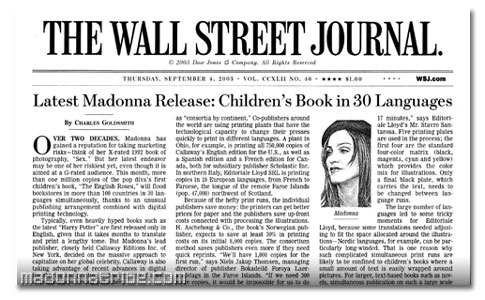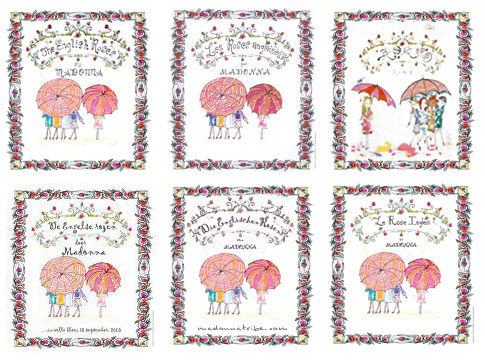EXCLUSIVE – Madonna’s Digital Multi-language Roses
Secrets and trivia behind the simultaneous worlwide publishing of Madonna’s forthcoming book in this article from The Wall Street Journal where you’ll discover how much Madonna’s english roses are italian, too.

Latest Madonna Release: Children’s Book in 30 Languages
By Charles Goldsmith
Over two decades, Madonna has gained a reputation for her marketing risks – think of her x-rated 1992 book of photography, – Sex. But her latest endeavor may be one of her riskiest yet, even though it is aimed at a G-rated audience. This month, more than one million copies of the pop diva’s first children’s book, “The English Roses“, will flood bookstores in more than 100 countries in 30 languages simultaneously, thanks to an unusual publishing arrangement combined with digital printing technology.Typically, even heavy hyped books such as the latest “Harry Potter” are first released only in English, given that it takes months to translate and print a lengthy tome. But Madonna’s lead publisher, closely held Callaway Editions Inc. of New York, decided on the massive approach to capitalize on her global celebrity. Callaway is also taking advantage of recent advances in digital file-sharing and printing technology and a web of relationships among publishers.
“We’ve never done something like this, all at the same time, ” says Giancarlo Stavro Santarosa, co-president of the italian company which is just one of several printing plants around the globe working to produce the jauntily illustrated “The English Roses”.
Nicholas Callaway, president of Callaway Editions Inc., describes the publishing arrangement as consortia by continent. Co-publishers around the world are using printing plants that have the technological capacity to change their presses quickly to print in different languages. A plant in Ohio, for example, is printing all 750,000 copies of Callaway’ s English edition for the U.S., as well as a Spanish edition and a French edition for Canada, both for subsidiary publisher Scholastic Inc. Copies in 18 European languages, from French to Faroese, the tongue of the remote Faroe Islands (pop. 47,000) northwest of Scotland are currently being printed in northern Italy.
Because of the hefty print runs, the individual publishers save money: the printers can get better prices and the publishers save up-front costs connected with processing the illustrations. H. Aschehoug & Co., the book’s Norwegian publisher, expects to save at least 30% in printing costs on its initial 8,000 copies. The consortium method saves publishers even more if they need quick reprints. “We’ll have 1,000 for the first run,” says Niels Jakup Thomsen, managing director of publisher Bokadeild Foroya Laerarafelags in the Faroe Islands. “If we need 300 more copies, it would be impossible for us to do that alone because the cost is just too high.”
Aiding in the process is digital technology, which has greatly increased the speed of preparing printing plates in different languages. The latest presses allow the plates to be changed much faster. Older printing methods required as many as two hours for language switches but we can now change to a new language in 15 or 17 minutes, says Mr. Starvo Santarosa. Five printing plates are used in the process; the first four are the standard four-color matrix (black, magenta, cyan and yellow) which provides the color mix for illustrations. Only a final black plate, which carries the text, needs to be changed between language runs.
The large number of languages led to some tricky moments, because some translations needed adjusting to fit the space allocated around the illustrations – Nordic languages, for example, can be particularly long-winded. That is one reason why such complicated simultaneous print runs are likely to be contained to children’s books where a small amount of text is easily wrapped around pictures. For larger, text-based books such as novels, simultaneous publication on such a large scale remains some way off, industry officials say.

Charles Goldsmith, The Wall Street Journal
